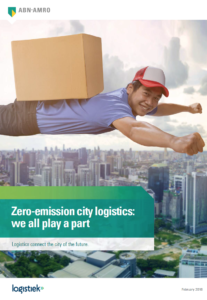Imagine, it’s Thursday 14 August 2025. Following a foggy start, the morning sun breaks through on this summer day. You don’t have to work today, so you decide to walk to your favourite café on the corner to have a cup of coffee, preferably on the terrace. On the way there, you picture yourself sitting there, stirring the foam on your cappuccino, feeling the sun on your face and enjoying the peace and views that the city offers.
Bart Banning from ABN Amro Bank pictures two scenario’s and a future perspective:
2025: the nightmare has come true
Who could have imagined that this would be the ‘new way of living’? Politicians and the business community, including the financial sector, have long struggled to understand how this nightmare could have been avoided. Many reports have been written about the impact of congestion in the city and how best to tackle this problem. Unfortunately, efforts to save the city have been hampered by slow decision-making, inconsistent policy, overly cautious funding for groundbreaking innovations, and the inability of shippers and parties in the logistics sector to combine forces due to a lack of trust.
Alternative view of 2025: the approach taken by the founders of city logistics 2.0 succeeded
This is a completely other scenario. Huge progress has been made as far as the use of existing transport capacity is concerned. Logistics of the most important urban flows of goods for the retail sector, hospitality sector and construction sector (these sectors were responsible for most of the congestion and carbon emissions in 2015) have been rigorously tackled. Although there has been a sharp rise in e-commerce, consumers have gained insight into their own online behaviour and factor this into the delivery times. And while congestion in the city centres has not disappeared entirely, it is limited to an acceptable level around a few new junctions. Most of the ambitious goals set in the past have been achieved. Even more importantly perhaps, the transition to a zero-emission city has become unstoppable.
Fortunately, it is 2018
We still have the opportunity to tackle the issue of clean city logistics. How can we do this? The simplest way would be to reconstruct a city from scratch. This is completely unrealistic, as the urban environments already exist and have their own history and ‘face’. In most places, greenfield developments are not allowed. However, innovative thinking based on a shared conviction is possible. And things can change if we all strive for this. But, the clock is ticking. Seven years may seem a long time, but it is not. We need to pick up the pace, right here, right now.
A new ABN Amro paper gives you insights on how to get to the city we all want to live in. Changing mindsets like Shared Value and Responsible Innovation are crucial in the motivation to achieve our clean city. This paper is based on a survey in the Netherlands.

